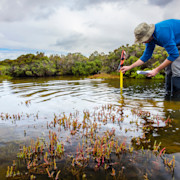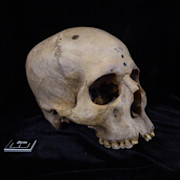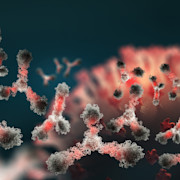- Science News
- Young Minds
- Carl Wilhelm Scheele – The Forgotten Chemist
Carl Wilhelm Scheele – The Forgotten Chemist

Frontiers for Young Minds takes you down on a dive into the depths of the historical scientific archives and introduces you to scientists you may have not heard about, but you definitely should! This time, we tell you the story of a scientist who is amongst the brave and brilliant researchers who formed the history of chemistry - Carl Wilhelm Scheele.
By Ilaria Prete
If you want to be sure not to go down in the glorious history of scientific discoveries, you could hardly do better than the example of the brilliant (but elusive) Swedish chemist Carl Wilhelm Scheele. He made a remarkable series of accomplishments as a chemist – most notably the discovery of oxygen – but the name of Scheele is rarely found in chemistry textbooks. The discovery of oxygen is generally attributed to his more famous contemporaries, Joseph Priestly, and the greatest Chemistry celebrity, Antoine Lavoisier. And yet, this hard-working and low-profile scientist discovered no less than seven new elements and many other compounds.
An (un)Impressive Beginning
Carl Wilhelm Scheele was born in 1742 in Stralsund, a small town on the Baltic coast (now part of Germany) that at the time was under Sweden’s jurisdiction. The son of a rather unsuccessful brewer and corn-chandler, young Carl developed a keen interest in chemistry and went on to become a good pharmacist. Although he had a brilliant mind, Scheele was a life-long supporter of the “phlogiston theory”, a fashionable alchemical theory of the time that postulated the existence of a fire-like element called phlogiston. According to Scheele and other alchemists, every compound that could be burned contained this phlogiston, and released it during combustion. Ironically, the phlogiston theory was debunked by Antoine Lavoisier in the 1770s thanks to his experiments on oxygen.
How Scheele Discovered Oxygen – And Failed to Report It to the World
After a series of moves around Sweden, Scheele settled down for a few years in Uppsala, already a celebrated academic center. There, Scheele met a prominent professor of Chemistry, Prof. Torbern Bergman, and together they embarked on a series of pioneering experiments to define the purity of saltpeter (potassium nitrate, also spelled ‘saltpetre’).
Bergman initially consulted Scheele as he was perplexed by the fact that saltpeter, when heated with acetic acid, produced a red vapor (now known as nitrogen dioxide). To help his friend, Scheele started heating various substances, including mercuric oxide, potassium nitrate, silver carbonate, manganese nitrate, manganese oxide, and more, all of which resulted in the production of odorless and tasteless gas that “supported the combustion of a candle more than air”, as Bergman stated in his report of the experiments a few years later. We don’t know the exact timeline of his experiments, since Scheele did not bother to keep accurate records. However, from his letters, we do know that most of these bold experiments occurred between 1770 and 1774. Scheele named this gas “Feuerluft” (fire-air), and remained absolutely convinced of the additional existence of phlogiston. Unfortunately, due to this wrong assumption, he did not report his “fire-air “discovery until 1777. Thus, the credit for the discovery of oxygen was attributed to Joseph Priestly, who published his own independent discovery of the gas in 1775. According to Priestly’s account of the discovery, this occurred on the 1st of August 1774. He had extracted oxygen from Mercurius calcinatus (mercury dioxide), as Scheele had done 2-3 years earlier.
An example of a chemistry lab of the 18th Century. (source: d. Königl. Schwed. Acad. d. Wissenschaft Mitgliedes, Chemische Abhandlung von der Luft und dem Feuer)
Scheele’s Other Discoveries – Which Were Also Overlooked By History
Apart from his passion for chemistry, Scheele was caught up by the very fashionable 18th-century craze for mineralogy, the study of rocks and minerals. He conducted various brilliant experiments on “black magnesia” or “pyrolusite” (a.k.a. manganese dioxide in modern terms), which led him to the discovery of chlorine. He successfully showed that chlorine was a powerful bleaching agent, highly corrosive of metals, and that it produced common salt (sodium chloride) if combined with soda. Unfortunately, Scheele’s phlogiston belief led him to call this “dephlogisticated muriatic acid” – it was later identified as an element and named chlorine by another chemist, Sir Humphry Davy.
Another forgotten discovery by Scheele was the extraction of a new element, molybdenum, from a mineral known as molybdenite.
You can find his name in the rather obscure mineral scheelite (now known as calcium tungstate) that Scheele liked to boil to obtain the even more obscure tungsten trioxide. More colorful is the discovery of Scheele’s Green (a.k.a. copper arsenite), named after him in recognition of his devoted (although dangerous) attention to the properties of arsenic. Finally, Scheele found new inventive ways of producing ether, magnesia, calomel, and phosphorus. The latter is perhaps his most influencing achievement, as can be seen in the prosperous match industry in Sweden.
A complete list of his discoveries covers: 4 gases, 6 inorganic acids, 8 organic acids, the isolation of glycerin and lactose, and the determination of the composition of Prussian blue (a.k.a. ferric ferrocyanide) and borax.

Statue of Carl Wilhelm Scheel in Köping, Sweden
Scheele’s Unsafe Dietary Habits – and Early Death
Scheele had the dangerous and unhealthy habit of tasting the substances he was working on – which is never a good idea if you are experimenting with chemical compounds, and even less so if you are interested in arsenic, lead, or other toxic metals -do not try this at home!
In 1785, Scheele showed symptoms of renal disease and a skin condition, probably caused by poisoning from heavy metals. He died in Köping at the early age of 43, in 1786.
Although he was undoubtedly the first discoverer of oxygen, his name is rarely mentioned along with his well-known rivals Priestly and Lavoisier, and his other discoveries did not bring him any fame or glory. He published one book, Chemical Treatise on Air and Fire in 1777, and kept up correspondence with many eminent and more celebrated scientists of his time – including writing to Lavoisier about his discovery of “fire-air” long before he published it!
This remarkable scientist kept a low profile throughout his life. It is high time that we recognise Scheele amongst the brave and brilliant researchers who formed the history of chemistry.
Do you know the story of a forgotten scientist that should be heard? Email us with your idea at kids@frontiersin.org!







